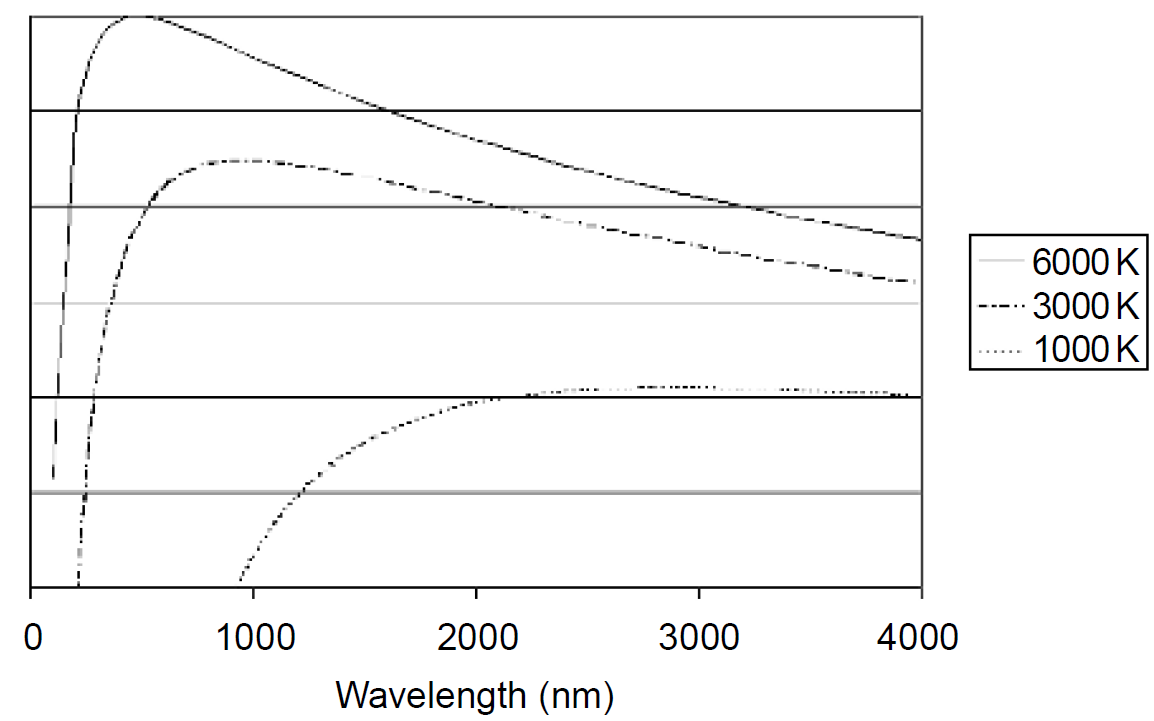
BLACKBODIES AT VARIOUS TEMPERATURES
 المؤلف:
Mark Csele
المؤلف:
Mark Csele
 المصدر:
FUNDAMENTALS OF LIGHT SOURCES AND LASERS
المصدر:
FUNDAMENTALS OF LIGHT SOURCES AND LASERS
 الجزء والصفحة:
p15
الجزء والصفحة:
p15
 7-3-2016
7-3-2016
 3226
3226
BLACKBODIES AT VARIOUS TEMPERATURES
To get an idea of how blackbody radiation depends on temperature, consider blackbody radiation curves for an object at various temperatures, as shown in Figure 1.1. Consider first an extremely hot object at 6000 K. Although a great deal of radiation is emitted in the infrared region of the spectrum, the vast majority

Figure 1.1. Blackbody radiation spectra.
lies in the visible range and more specifically, in the blue region of the visible spectrum. Such an object is said to have a color temperature of 6000 K and approximates that produced by sunlight. Many commercial lamps, especially those used by photographers, have a color temperature rating like this; it is simply a comparison to an equivalent output from a blackbody radiator. Considering a somewhat cooler object at 3000 K, the object appears red when viewed since there is a great deal more red light emitted than blue light. Incandescent lamps often have a color temperature around 3500 K, and photographs taken under such light appear reddish yellow and require a blue correcting filter to have accurate color reproduction. This point is also illustrated in the differences between light from a regular incandescent lamp and a halogen lamp. In halogen lamps the filament burns in an atmosphere of halogen gas (e.g., iodine) which allows the filament to burn much hotter than in an ordinary incandescent light bulb without burning out prematurely. The increased temperature results in a shift from the reddish-yellow (warmer) light of an ordinary incandescent lamp to a much whiter light (i.e., containing more blue). Halogen lighting is therefore often used for illumination of objects where truer color rendition is required (e.g., display of artwork). As this object cools to, say, 1000 K, the emission of light shifts even further into the infrared, and only a small amount of red light is emitted (with almost no blue). Such an object is said to be “red hot” and the vast majority of its emission is in the infrared region between 2- and 6-μm wavelengths. The red we see is only a tiny fraction of the total radiation emitted. Objects at room temperature (300 K) also emit radiation in the infrared centered at about 10 μm. In fact, even objects at a cold 3 K (the background temperature of the universe found in deep outer space) emit radiation at 3-μm wavelengths. Such long wavelengths are in the microwave region of the spectrum and can be detected using sensitive microwave receivers. Cosmologists often call this microwave background the “leftovers” from the “big bang” that created the universe.
 الاكثر قراءة في الضوء
الاكثر قراءة في الضوء
 اخر الاخبار
اخر الاخبار
اخبار العتبة العباسية المقدسة


